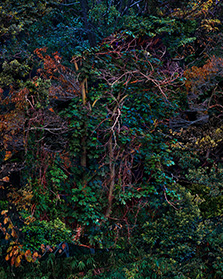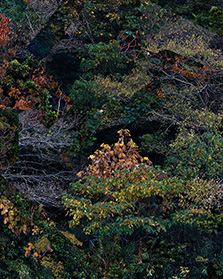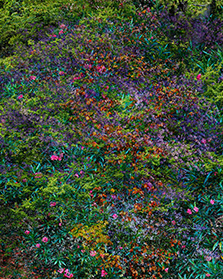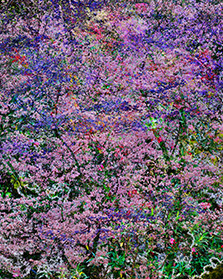Boundaries
In 2016, when I photographed the vicinity of the Imperial Palace, I grew interested in the fact that this was where the city of Edo/Tokyo originated, in this quasi-liminal area that once faced the sea, and I began to think deeper about boundaries in urban spaces. The area where I live is riddled with geographical undulations, some of them steep like a cliff. It once directly bordered Tokyo Bay, and its kilometer-long precipices acted as a border between land and sea. This area is mainly the subject of this series. The cliffs are now overgrown with trees and grass and other greenery to the extent they appear like a forest. But this is a forest that is completely flat, lacks any depth, and rises up vertically. I sense a unique ambience here, one that belongs to boundaries and fringes. And as if to lend substance to this feeling, the area happens to be dotted with shrines, torii gates, graves and small worshipping sites—places that symbolize the divide between life and death, between this world and the next.
In the beginning I took photographs and made prints for each separate location, as if trying to shoot portraits. But then, when I was throwing around prints with the white border cut off, I noticed a new kind of space created from the overlapping images. Though they had been taken at different times and places, they corresponded in such a way as to form a new, beautiful space and time. I found myself fascinated by this accidental beauty that emerged in the periphery of carefully created photographs. The series came into existence when I experimented with the computer to reproduce the time-space created by the interactions of the prints. In the beginning I arranged and overlaid fragments cut straight from multiple images, but later decided to layer and combine elements such as leaves, branches, trees, flowers and so on as ready-made shapes. This approach may fall under the umbrella of the collage, but I think a more fitting word would be ‘recombine.’ In collages, image parts are added and arranged to gradually complete the whole. Recombining, however, involves the rearrangement of a limited set of image data, and the whole continues to change unexpectedly and in unforeseen ways.
Places and seasons interact and influence one another in the two-dimensional plane of these images, allowing the emergence of a complex, fluctuating space-time with no clear differentiation between up and down. This real, multi-layered and multi-temporal space-time differs from the easily-perceived perspectives of conventional photographs. The resulting images defy empathy, and they bring out the inherent materiality of photography.





















